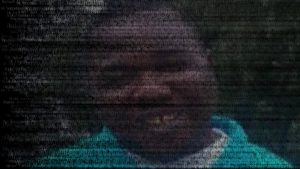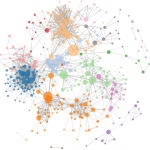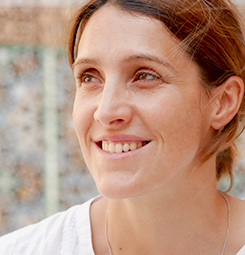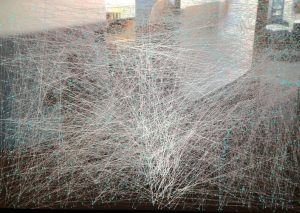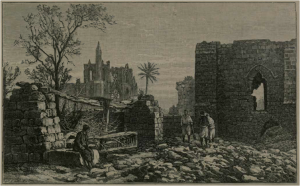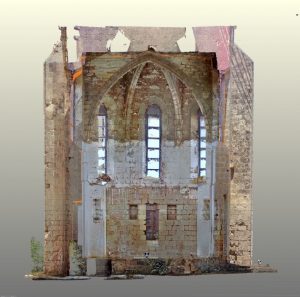
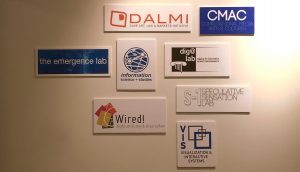
The CMAC-associated Labs
The Rendezvous is a regular gathering of Duke community members interested in exploring media arts, sciences, information, and cultures through informal project presentations and exchanges. Unless otherwise specified, we usually meet in the Smith Warehouse, Bay 10, 2nd floor, in the Collision Space on selected Thursdays at 4:30PM (unless otherwise indicated) during the academic year. (Fall 2012-Spring 2015 Archives)
Please contact our Rendezvous organizer, Patrick Herron, if you are interested in sharing your work with us.
Upcoming 2018-19 Rendezvous Events
November 01, 2018: Nevio Danelon, The Trajan’s Puzzle Project in Rome, Dig@Lab, CMAC, Duke
The Trajan’s Puzzle Project is part of an exhibit commemorating the 1900th anniversary of the death of Emperor Trajan, 2017. The reign of Emperor Trajan (98 AD – 117 AD) marked the highest point of the Roman Empire claiming the peak of the empire’s territorial expansion. The project focuses on the Trajan Forum and in particular, the Basilica Ulpia, the largest basilica of the Roman world. The work consisted of architectural and sculptural re-imagination to guide visitors through a kaleidoscope of lost masterpieces.
Our contribution to the exhibit consisted of four major installations: a table with holographic prints, a scale cutaway model of the basilica created by 3d printers, an Augmented Reality app, and a tangible table interface. They will work in tandem to highlight and guide viewers to focus on historically significant Roman frieze fragments.
Past 2017-18 Rendezvous Events
September 14, 2017: Kickoff Event
CMAC-associated lab working groups will briefly introduce themselves as we enjoy food and drink and catch up with one another. Come learn about CMAC and form new friendships.

Bill Seaman and John Supko
September 21, 2017: Bill Seaman, John Supko, Emergence Lab, CMAC, Duke
Since 2014, the Emergence Lab has been a site of interdisciplinary teaching, research, and collaborative creative work at the undergraduate, graduate, and faculty levels. Through its cross-listed seminars, exhibits, and publications the Emergence Lab facilitates new ways of making and thinking about art in multiple media. It aims to include as many Duke students and faculty as possible in these explorations.
September 28, 2017: Quran Karriem, PhD student in CMAC, Duke
Meet Quran Karriem, an experimental musician, game designer, former software executive, and new PhD student in the Computational Media, Arts & Cultures (CMAC) program. Karriem will discuss his current research, artistic interests, and selected past projects. Karriem will give special attention to his new work, endings, which opens this week. endings is a generative text and audiovisual work that engages with a dataset on fatal encounters with police in the US since January 1, 2015. The dataset is actively maintained by The Washington Post, and each new entry is incorporated into the piece.
We encourage everyone attending Karriem’s Rendezvous talk to stay after the talk and celebrate the opening of endings, which will be showing at the Installation Array in Smith Warehouse, Bay 11, from September 26, 2017 through October 20, 2017.
Snacks and drinks served, including cava and beer.
October 12, 2017: Evan Donohue, PhD candidate in CMAC, Duke
“Inventing Emotions: The Past (And Future) of Emotional Machines”
Artificial intelligence represents one of the most visible encounters between the scientific demand for objective models, and the nebulous human categories that inevitably evade them. In this talk, Evan Donahue will chart the history of the idea that machines can–and should–interpret and display emotions, and discuss the interpretive stresses placed on the concept of “emotion” by the need to produce tangible robots that display it. Donahue’s aim is to locate a discursive “trading zone” in which scientific and humanist discourses of “the emotions” can productively exchange inspirations and insights, and speculate about what a fully realized science of “artificial emotion” might look like.
Evan Donahue is a Ph.D. candidate in the Computational Media, Arts & Cultures program. His work focuses on sites of collision between scientific and humanist discourses, and the knowledge practices that result. In his dissertation, Android Linguistics, he examines how the field of artificial intelligence has historically reinterpreted–and continues to reinterpret–concepts such as metaphor, narrative, emotion, language, and logic, and the consequences such reinterpretation holds for the technologies that result.
October 19, 2017: Salman Sajun Studio
“Non-stop stop motion with Salman Sajun Studio”
“A walk though of who we are, What we do and How we do it. Along with a slight deep dive into some projects and how we solved and overcame some challenges creatively.”
Salman Sajun (Director) is a director who runs a creative studio that specializes in bringing the inanimate to life through a blend of stop motion and live action. He shares with his creative team the goal of making the world, “a colorful more aesthetically pleasing place where imagination runs wild and creativity drives all content.” As a director Sajun has created dozens of commercials and short films for clients all around the world.
Anna Berezowsky (Lead animator) brings problem-solving, perseverance, and technical skill to realize even the most challenging of projects. She is an experienced stop motion animator whose methods help people to see ordinary objects in new ways. Sajun writes, “striving to give motion and personality to the seemingly impossible, [Berezowsky]’s commitment to craftsmanship is in every frame.”
Co-sponsored with the AAHVS Visiting Artist Series.
October 26, 2017: Jacob Hill, PhD student, School of Information & Library Science, UNC-Chapel Hill
“Citation Networks as Reading Infrastructure”
Citation networks have been useful in information retrieval on the web, modern evaluations of academic research, identifying the boundaries of disciplines, academic research in the history of ideas, and a number of other areas. It stands to reason that applying similar techniques to historical texts would also prove fruitful. A number of challenges must be overcome first, however. I will briefly describe the texts and the technical hurdles to automatically detecting citations and then pose a few theoretical challenges relating to the interpretation of citations. We will spend the remainder of the session talking through some of these challenges.
November 2, 2017: Matthew Kenney, Information Technology Analyst, Art, Art History and Visual Studies
“Race, Algorithm and Cloud Architecture”
Machine learning and artificial intelligence have the capacity to create novel insights. However, these same techniques also have the capacity to create biased and discriminatory outputs. I will review the technical and conceptual aspects that produce biased artificial intelligence models, and discuss implications.
We encourage everyone attending Matthew’s Rendezvous talk to stay after the talk and celebrate the opening of YOLO, which will be showing at the Installation Array in Smith Warehouse, Bay 11, from October 30, 2017 through November 20, 2017.
November 9, 2017: Maurizio Forte and Nevio Danelon DIG@LAB, Digital Digging Laboratory, CMAC, Duke
“Smart Archaeology and ArcheoRobots”
Smart technologies involve the use of different collaborative and intelligent tools able to automatize several activities performed in the environment and in everyday objects. In archaeology, smart technologies can include sensors, close range sensing systems, robots, rovers, drones, laser scanners and specific software able to process data from multiple sources. The impact of smart technologies in the next decades will be revolutionary also for the social sciences, the humanities and the sciences of the past.
Maurizio Forte is William and Sue Gross Professor of Classical Studies, in Art, Art History, and Visual Studies, and is the Director of Dig@Lab (https://diglab.org/). Nevio Danelon is a postdoctoral associate in Art, Art History, and Visual Studies and a member of the Dig@Lab.
As always, drinks and snacks will be served.
November 16, 2017: Raquel Salvatella de Prada, Assistant Professor of the Practice of Visual Arts, Duke
“Cornered (a work in progress)”
Raquel Salvatella de Prada will be showing her work in progress for “Cornered,” a video installation that represents the motivation and struggles of African immigrants leaving their home country and making an attempt, most often failed, to cross the border from Morocco to the Spanish cities of Melilla and Ceuta, the only European cities on Africa’s mainland.
The installation features video projections on a stylized Moroccan table with a dome covering the top area and the viewer sees the video projection by walking around the structure.
Raquel Salvatella de Prada is a computer artist and assistant professor of the practice of Visual Arts at Duke University. Her work often focuses on integrating computer animation and motion design with different traditional art forms by collaborating with artists of diverse backgrounds such as printmaking, painting, installation art, poetry and performance. She finds that the combination of her digital medium with physical visual media can be a powerful way to communicate social issues. Her experimental animation work and collaborative performance pieces have been featured at festivals and on stages across the country and internationally.
As always, drinks and snacks will be served.
CANCELED DUE TO WEATHER /// January 18, 2018: Sara Galletti, Kristin Huffman, Paul Jaskot, Ed Triplett, Victoria Szabo, Wired Lab, Duke University
“Objects, Buildings, and Cultural Spaces: Archival Sources, Digital Visualization and Intellectual Problems at the Wired Lab”
In a series of lightning talks, Wired! faculty will present their research projects and the digital methods they have been using for their analysis. In the spirit of intellectual collaboration, we will approach these diverse art historical projects from the overlapping question of scale: the scale of the physical object(s) of analysis but also the scale of the data. In addition, we will discuss how the particular research question has raised the need for specific computational methods, including GIS, 3D modeling, viewshed analysis, Augmented Reality, and others.
January 25, 2018: Scott Lindroth, Professor of Music, Duke University
“Cadences: Instrumental Music, Computation, and Text”
Cadences (2016) is an instrumental sextet that uses the rhythms of spoken phrases excerpted from Richard Powers’ novel Orfeo as source material. Extended rhythmic and melodic phrases in Cadences are generated algorithmically with open source music synthesis software called SuperCollider and notation software called LilyPond. Related musical concerns include the resolution of rhythmic dissonance, approaches to repetition, and instrumental textures derived from speech rhythms.
February 01, 2018: Danny Kim, MFAEDA Candidate, Duke University
“Looking North”
Looking North is a collaborative multimedia exhibition by Danny Kim (MFAEDA ’18) and Peter Lisignoli (MFAEDA ’13) examining the landscapes of the demilitarized zone (DMZ) at the border between North and South Korea. As an outsider, this was Lisignoli’s second visit to the DMZ area, the experience left him with a feeling of displacement. The serene landscapes of the 38th parallel were strangely memorialized with museums, gift shops, and amusement park. Kim, a native Seoul-born Korean citizen who served in the military was struck by the oddity of the DMZ theme park where tourists looked longingly though the telescopes across the Imjin River, fascinated by the neighboring country, after more than six decades of separation.
February 15, 2018: CMAC Students for the Graduate Student Symposium
CMAC doctoral students Max Symuleski, Evan Donahue, Quran Karriem, Rebecca Uliasz, and Eylul Iscen will each briefly present current projects, providing the range of PhD work in CMAC.
February 22, 2018: Rebecca Uliasz
“leaking, breaking, hiding in plain sight: an artist talk”
Rebecca Uliasz, first year PhD student in CMAC, will give an artist talk on recent past and pending future projects. Uliasz conducts research in time-based media, which supports an artistic practice that incorporates physical experience mediated by telecommunications systems. She utilizes an interdisciplinary approach to investigate the intersections of live electronic performance, audio and visual processing, machine learning, and critical making. Her work engages with contemporary technologies in order to create aesthetic systems that seek to question the relationship between perception, experience, structure, meaning-making, and consciousness. Her work commonly takes the form of interactive installation, virtual objects, time-based performance, A/V noise improve, custom made hardware and software tools, and multi-media collaboration.
March 01, 2018: Patrick Herron, Senior Research Scientist/Lecturing Fellow, Information Science + Studies, Duke University
“Visualizing Discursive Formations: Computing Archaeologies of Knowledge”
How might a person read and express a library, understand what it does and does not say, what it favors and what it discounts? How might we begin grasping how media makes us who we are collectively and individually? Senior Research Scientist Patrick Herron has struggled with these questions since the 90’s when working in a government cancer research lab and developing augmentative computational methods for constructing and deconstructing poems. Herron will first give a brief review of his interdisciplinary work applying text mining to a broad array of topics. Herron will then present a method for visualizing specific types of distinctive formations within digital archives both synchronically and diachronically through examples, including an extensive analysis of Hollywood’s production of the military entertainment complex.
March 29, 2018 (Rescheduled from January 18): Sara Galletti, Kristin Huffman, Paul Jaskot, Victoria Szabo, John Taormina, Ed Triplett, Wired Lab, Duke University
“Objects, Buildings, and Cultural Spaces: Archival Sources, Digital Visualization and Intellectual Problems at the Wired Lab”
In a series of lightning talks, Wired! faculty will present their research projects and the digital methods they have been using for their analysis. In the spirit of intellectual collaboration, we will approach these diverse art historical projects from the overlapping question of scale: the scale of the physical object(s) of analysis but also the scale of the data. In addition, we will discuss how the particular research question has raised the need for specific computational methods, including GIS, 3D modeling, viewshed analysis, Augmented Reality, and others.
April 05, 2018: thomas f. defrantz, SLIPPAGE, Duke University
“SLIPPAGE:Performance|Culture|Technology: Moving through Theories and Performances”

How does anyone combine careers as artists and academic researchers? Where do creative communities and intellectual communities converge? What is it like to work in a university and also as a freelance artist? In this final CMAC Rendezvous of 2017-18, SLIPPAGE director thomas f. defrantz will share ideas about working inside and outside various institutions and how creative projects materialize differently in varied contexts.
Past 2016-17 Rendezvous Events

Joyce Ogburn
September 22,
2016: Joyce Ogburn, University Librarian, Appalachian State Univ, @ The Edge/Open Edge Series
Our kickoff event for the 2016-17 season will be hosted at The Edge in order to promote the series while connecting with our friends in Duke Libraries. Joyce Ogburn, former University Librarian at Appalachian State, will be giving a presentation on issues deeply related to open scholarship in practice.
Title: “Principles of Scholarly Communication: Informing Policy, Influencing Practice”
Brief abstract: Concurrent with the growing attention to the viability and values of scholarly communication, many new and existing groups have developed principles to inform and guide changes in policy and practice. Often, these principles are documented within formal statements, declarations, resolutions, directives, and policies. I will present a broad review of representative and influential documents and principles on which change has been based, as well as how principles are reflecting the evolution of expectations for access to and use of scholarship. A discussion will follow to address how principles might continue to be expanded, along with the roles of librarians and others in the future of scholarly communication. (ISS Lab; general interest)
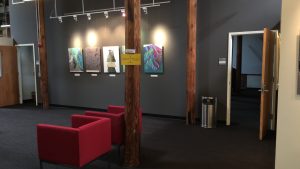
The Collision Space, Bay 10, 2nd Floor, Smith Warehouse
September 29, 2016: Open Social Event in the Collision Space
Come mingle with the CMAC-affiliated labs in Smith Warehouse and share in drinks and snacks while you do. It will be a great time to catch up and form new friendships.
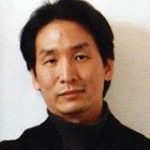
Ja-Young Ku
October 6, 2016: Ja-Young Ku, Associate Professor, Contemporary Arts, Konkuk University
Convergence of Time Collage: Networked and Database Driven Interactive Media Art
In <<Arrays_C>>, I created a stream socket based work to enable viewers to interact with their mobile app and thus allow them to draw on their phone’s screen, which then instantly sends the drawings to a remote electronic board in a public space. Anyone who downloaded the app could participate in the piece by simply drawing with their fingertips. Drawings were then stored in a database and converged with other’s drawings later on different days. In this piece, I tried to allow viewers to think about memories and drawings as interactions of different times and space. (Emergence Lab)
October 20, 2016: Mike Thomas, SAS
Mike Thomas of SAS (Cary, NC) will present on work at the intersection of IoT, VR, and data analytics. (ISS Lab; general interest)
Seeing IoT with AR and VR
Brief Abstract: IoT is about data, but that doesn’t mean we have to be stuck with paper-based data visualization practices dating back to the late 1700’s. Instead, we can see IoT in its natural state by utilizing AR and VR.
October 27, 2016: Humanities Meaning + Mining Student Presentation from Madeline Snipes, Sarah Hendrix, Kelsey Graywill
Undergraduates Sarah Hendrix, Kelsey Graywill and Madeline Snipes will present their final project from their Spring 2016 semester’s course on text mining and meaning (ISS 290/VMS 290). The three students created an impressive comparative analysis centered on fan fiction using data exploration and text mining, generating novel ways of reading literary texts in the process. (ISS Lab)

Jeffrey Ritter
November 3: Jeffrey Ritter, Visiting Fellow, Kellogg College, University of Oxford
“Quantum Law: First Principles”
How will we govern humankind after the quantum computers are built? What are the balances between efficiency and ethics? How might new systems of regulation be advanced with visual innovations that improve governance? Joining us is Jeffrey Ritter, a new Durham resident and Visiting Fellow at Oxford University, where he teaches in the Department of Computer Science and is conducting research to try and answer those questions.
November 10, 2016: Maurizio Forte on Vulci 3000, the 3D Digital Recording of an Archaeological Excavation to illustrate the results achieved during 2016 summer fieldwork in Italy (Dig@Lab)
December 1, 2016: Ryan Shaw, Analyzing and Visualizing Data from Mobile Health Technologies
In our current healthcare system, health care is organized primarily around episodic interactions with patients. The challenge with episodic care in many illnesses is that patients to do not receive interventions when and where they need them most – at the time when a problem is about to occur, or is occurring. This presentation will discuss the use of mobile health technologies as tools to shift healthcare from episodic to real-time care. In particular, we will focus on analyzing and visualizing data from mobile technologies and their integration into the healthcare ecosystem. Examples will be presented from completed and ongoing NIH-funded clinical trials.”
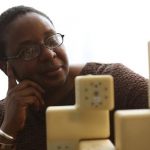
Pamela Jennings
December 8, 2016: Pamela L. Jennings is a unique individual— engineer, researcher and artist. She has held a number of interesting positions including teaching positions in the arts where she has sought to develop multiple research projects in human-centered computing. As Director of the Earl and Brenda Shapiro Center for Research and Collaboration at the School of the Art Institute of Chicago (SAIC),
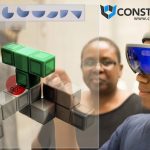
Construkts
Jennings worked to build bridges between SAIC’s community and civic, academic, and industry partners. Earlier she taught at Carnegie Mellon. She is unique in her interests in bridging art and science in that she led the National Science Foundation’s CreativeIT program that supported cross-disciplinary projects combining creativity, computer science, and information technology. She has truly helped to build the emerging art, science, and technology fields. She recently left her exciting post as director at the Center for Design Innovation and is currently working on a fascinating set of projects in the private sector.
January 26, 2017: Tim Senior, Adventures in Multi-Disciplinarity

Tim writes, “I first came to Duke, quite by chance, in 2008. Looking for a different direction after a PhD in Neuroscience, my new colleagues equipped me with no less than three. As part of this semester-long return visit to Duke, I’ll be presenting the current state of this work, once again in search of new insight and inspiration: The first is a long-standing digital humanities project – a scholarly reconstruction of the St Catherine Dominican monastery in Bremen (Germany), a remarkable, but largely unstudied, site that links an Evangelical Martyr, the Rockefeller foundation, and Brutalism; the second concerns the intersection of the arts & humanities, STEM, and business – I’ll present ongoing work as part of the UK’s Creative Economy Hubs endeavor, a program initiated by the UK’s Arts and Humanities Research Council nationally to pursue innovation in cultural, creative, and digital economy; the third concerns the emergence of living media as a target for contemporary scientific and artistic practice – a new book project with artists and researchers from South Korea, UK, France and Switzerland. Complex systems and Human Microbiomes abound.”
February 2, 2017: Matthew Kenney, Making Data Physical

“algo2.2,” Matthew Kenney
Matthew writes, “My work uses algorithmic and data driven sound rendering and visualizations as an opportunity to explore perception, chance, and information. I create systems to explore data and algorithms physically and sonically through 3D printing, data sonification and physical computing. In this presentation, I will present several projects that explore how I have used data and algorithm as a base to drive my art and design, and walk through my process transforming numbers to physical output.”
February 9, 2017: Cosimo Monteleone, University of Padua, ‘The representation of space: “La pratica della perspettiva” by Daniele Barbaro’
This presentation will provide a quick overview on the problem of representation of space from classical era to Renaissance and focuses on a treatise titled “La pratica della perspettiva”, printed by Daniele Barbaro in 1568.
The book had an important role in the art and architectural theories at the end of the Renaissance as well as in the following centuries.

To compose his book Daniele Barbaro borrowed from the works of his predecessors, but, with pioneering attitude predating the scientific method, he also dealt with perspective in all its aspects.
Three manuscripts, preserved at Biblioteca Nazionale Marciana in Venice, provide information on perspectival matters not mentioned in the printed book and new technologies of communication show and disseminate in a new way Barbaro’s principles and rules on perspective.
February 16, 2017: David Rambo, Doctoral Candidate, Duke (S-1 Speculative Sensation Lab)
“Contact Traces: On the Levity of Gore in Video Games”
David’s project considers “blood and gore” in video games as non-mimetic marks of action and expressions of exuberance. Whereas past studies of video game graphics tend to focus on representations of violence, often with an unfounded moral concern, David argues that apparently gratuitous instances of blood and gore align graphical fidelity not with realism, but toward what Gérard Genette terms in his study of painting “abstract figuration” and “nonfigurative abstraction.”
Blood and gore is accordingly self-presentational with respect to its own audiovisual and ludic materiality, and understanding it requires an aesthetic analysis at the level of forms and of that level’s constitutive techniques.
Games discussed: Bloodborne, Dark Souls, Defender, Doom (2016), Galaxian, Geometry Wars, Hotline Miami, Resogun, Robotron: 2084, Smash TV.
Keywords: gore, video games, computation, visual media, form, formalism, Brinkema, Genette, Whitehead.
March 2, 2017: Tessa Joseph, UNC-Chapel Hill
The aim of Tessa Joseph-Nicholas’ recent collaboration, “Coding Diversity, Diversities of Code”, was ostensibly to develop a low-threshold online interface that would allow data-naive humanists to explore the social media conversation around inclusion and diversity in technology. It turned out to be a rank-crossing, transdisciplinary, pedagogy-driven collaborative experiment whose processes and reception seemed to have been designed to force a reckoning with the rhetorics of diversity/inclusion, technology, learning, research, transdisciplinarity, and, most especially, the digital humanities. In this talk, Joseph-Nicholas will discuss what happens when the process of a project turns out to be the project itself.
 Tessa Joseph-Nicholas is Senior Lecturer and Director of Digital Arts and Humanities Projects in the Department of Computer Science and a Faculty Fellow of the Digital Innovation Lab and the Institute for the Arts and Humanities at the University of North Carolina at Chapel Hill. Her teaching and research explore histories of computing and the Internet, Internet cultures and communities, digital fictions and poetics, the digital humanities, and programming instruction for non-programmers. She believes in net neutrality, hybrid pedagogy, transdisciplinarity, demystification, inclusion, and compelling, risky, joyful work.
Tessa Joseph-Nicholas is Senior Lecturer and Director of Digital Arts and Humanities Projects in the Department of Computer Science and a Faculty Fellow of the Digital Innovation Lab and the Institute for the Arts and Humanities at the University of North Carolina at Chapel Hill. Her teaching and research explore histories of computing and the Internet, Internet cultures and communities, digital fictions and poetics, the digital humanities, and programming instruction for non-programmers. She believes in net neutrality, hybrid pedagogy, transdisciplinarity, demystification, inclusion, and compelling, risky, joyful work.
March 9, 2017: Luke LeGrand, CMAC Master’s Candidate, Duke, “Misspent (%d)Ohs or (%d) The Simpsons”
The Simpsons has been a seminal part of global culture for decades. On any subject from physics to religion, the first family of American media has been asked to intervene. Accordingly, The Simpsons has been analyzed to pieces. We seek to read The Simpsons differently, creating a schizo-analytic theoretical frame through which to interpret the output of distant reading and topic modelling techniques. With more than 600 episodes over 28 seasons, The Simpsons is a rich corpus for analysis at any register. Our central questions are: What does the show communicate? How does the show communicate? And, why has the show enjoyed such long lived global appeal? In order to fully answer these questions, we will not only employ data analysis, machine learning, and data visualization, but will then leverage this information to create interfaces for new ways of experiencing The Simpsons.

Jim Davies, Carleton University
March 23, 2017: Jim Davies, Carleton University (CN), “A Vision for the Science of Imagination”

Imagination is a crucial process for hypothetical thinking, planning, dreaming, counterfactual thinking, and creativity. In this talk Davies will present how imagination can be studied scientifically, and the various endeavors he is currently pursuing in the Science of Imagination Laboratory in the Institute of Cognitive Science at Carleton University.
March 30, 2017 4 PM: SPECIAL JOINT EVENT with the Digital Humanities Summit
Thursday, March 30, the Rendezvous will be getting an early start at 4 PM for two events. First, we will hold a reception for the opening of Ja-Young Ku’s new installation, “D910,” in Bay 11 of Smith Warehouse. Then at 4:30 in the usual space for the Rendezvous in Bay 10, we will host a round table event for the Digital Humanities Summit led by Ed Triplett and Brian Norberg.

Ja-Young Ku
4:00 PM, Bay 11, 2nd floor: A reception for the opening of “D910” by Ja-Young Ku, Konkuk University. “D910” is an interactive media work that draws hundreds of lines, all connected, floating around in a virtual space augmented with the image of the actual exhibition space itself. The viewer’s image is projected into the virtual space, then separated into two in time to subsequently interact with the lines.
 4:30 PM, Bay 10 Collision Space: Dissecting Humanities GIS Projects: Cross-sections, Guts and a Good Story
4:30 PM, Bay 10 Collision Space: Dissecting Humanities GIS Projects: Cross-sections, Guts and a Good Story
Ed Triplett and Brian Norberg, Duke University
GIS is often referred to as an easy entrance point into digital humanities because so many scholars in a range of humanities disciplines can “see” their subject spatially in their mind’s eye before they ever begin learning digital mapping tools. Like any other form of scholarship, it is important to set the scope of a spatial humanities project early in the process, but this is easier said than done. The purpose of this lecture and round-table discussion is to construct a cross-section of the spatial humanities process by dissecting a handful of projects according to their purpose, tools chosen, required knowledge, and audience. Brian Norberg and Ed Triplett will place a number of projects on the operating table, pull out some guts and make inferences about how they were built, and with what levels of difficulty. By the end of the first hour, the dissected projects will be pinned up in a range from the simplest, easiest to build spatial projects, to the most complex, custom-built web-maps. The second hour will be an open discussion about how we can grow spatial humanities at Duke horizontally in the classroom, as well as vertically with cutting edge GIS projects. What do we have at our disposal at Duke to accomplish different kinds of spatial projects? How do we jump the gap between desktop GIS and web-GIS? What are the unique features that we need as humanists that software designers don’t prioritize?
Brian Norberg is Digital Humanities Technology Analyst in Duke University’s Trinity College of Arts and Sciences Technology Services, where he collaborates with students and faculty to incorporate technology into Humanities courses and research. Much of this work involves consulting with researchers to advise on technical solutions and implementing technologies to enable innovative research in areas like social media, historical GIS, and digital archives. He holds a Masters degrees in English Literature and Library and Information Science.
Ed Triplett is a CLIR Postdoctoral Fellow at the Duke Library working on data curation for visual studies, and a future Lecturing Fellow in the AAHVS Department. Ed works closely with the Wired! Lab and other groups on campus to help build and manage digital mapping and 3D modeling projects. He holds an MFA in 3D Modeling and Animation, MAs in History and Architectural History and a PhD in Art and Architectural History. Ed’s research has focused on the architectural history of medieval Iberia’s contested religious frontier.
April 13, 2017: Michael J K Walsh, NTU Singapore, “‘Prayers Long Silent’: Protecting endangered heritage in post-conflict Cyprus”
The walled city of Famagusta, Cyprus, with its French Gothic churches, exquisite 14th-century frescoes, towering Venetian walls, domed Ottoman hamams, and majestic British Imperial architecture, should be a UNESCO World Heritage Site – but it is not. Instead, as a result of the Turkish military intervention in 1974 and the ensuing political stalemate that exists to this day, the city and its heritage have become dangerously isolated – its architectural and art-historical treasures within its walls virtually forgotten.
Following the successful nomination of Famagusta to the World Monuments Fund (WMF) Watch List in 2008 and 2010, Nanyang Technological University in Singapore (with the WMF and the Famagusta Municipality) led a series of international efforts to protect, stabilize and study Famagusta’s irreplaceable heritage, and in particular its extant murals. This presentation will discuss this initiative, and highlight the interdisciplinarity of the project ranging as it did from emergency mural conservation to VR reconstruction; from pedagogical projects to the intricacies of international law; from GPR mapping to 700 year old Armenian archives. The presentation will include the screening of a short documentary film produced to highlight the relationship between culture and politics, and the interface between art history and technology.
Michael J. K. Walsh F.R.S.A., FRHistS., conducted his graduate studies at the Universities of St. Andrews, Cambridge and York, before joining the Department of Archaeology and Art History at Eastern Mediterranean University, Famagusta. In his time there he successfully nominated the historic city of Famagusta for inclusion in the World Monuments Fund Watch List (twice) and also acted as team coordinator for the United Nations project ‘Cultural Heritage Data Collection in the northern part of Cyprus’. He has edited and co-edited four books on Famagusta, including Medieval and Renaissance Famagusta (Ashgate, 2012), Crusader to Venetian Famagusta (Central European University Press, 2014), Famagusta: Contemporary Images from an Historic City (Datz Press, 2015), and City of Empires: Ottoman and British Famagusta (CSP, 2015). A fifth book entitled Prayers Long Silent: Famagusta’s Armenian Church and the Complexity of Cypriot Heritage will be published by Palgrave MacMillan this week. He is currently Associate Professor of Art History at the School of Art, Design and Media at Nanyang Technological University in Singapore.
Duke Media Arts + Sciences Rendezvous Archives, Fall 2012-Spring 2015


